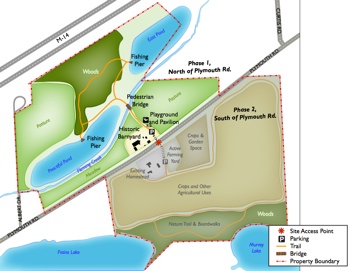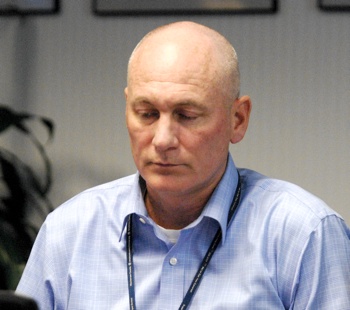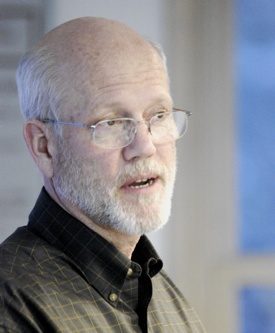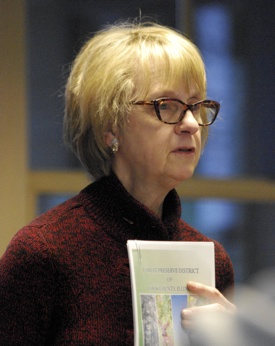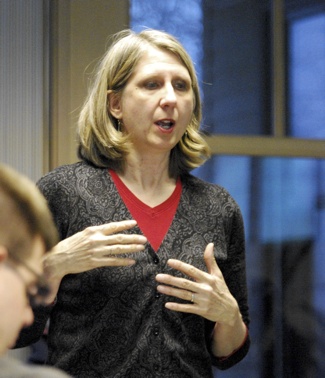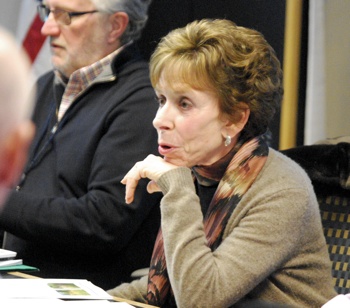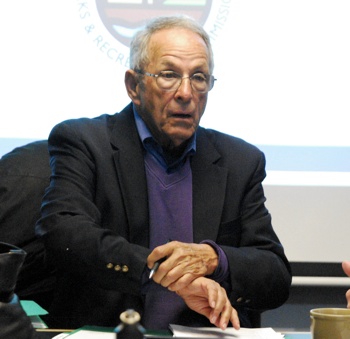County Parks Commission Gives Trail Grants
Washtenaw County parks & recreation commission meeting (March 11, 2014): Commissioners approved an application for state funds to develop a major new recreation area just northeast of Ann Arbor. They also awarded $600,000 in grants for trail projects throughout the county.
Commissioners approved an application to the Michigan Dept. of Natural Resources trust fund for a grant to help develop Staebler Farm for recreational use. WCPARC has owned the 98-acre property in Superior Township since 2001, and Donald Staebler – who is 103 years old – still lives there in a lifetime agreement with WCPARC. The plan calls for adding fishing piers to the property’s two ponds, as well as putting in a trail system and other features. A second phase might involve developing a farm incubator program.
Commissioners also awarded $600,000 in grants through WCPARC’s Connecting Communities program, which supports trail projects throughout the county. Grants were given to projects in Ann Arbor Township, Northfield Township, Pittsfield Township, and the village of Manchester.
In non-voting business, WCPARC director Bob Tetens gave an update on the east county recreation center, a proposed partnership between the city of Ypsilanti and WCPARC in which the city would supply the property and WCPARC would provide the building. The center would be located on part of the 38-acre Water Street redevelopment area. Tetens said they’ve been working with the city of Ypsilanti on a development agreement.
Ypsilanti mayor Paul Schreiber and city councilmember Pete Murdock both spoke to the commission about Water Street during public commentary. Schreiber told commissioners that he wasn’t aware of any “show-stopping” issues. He also gave an update on Water Street Flats, an apartment project that’s planned for the site. The complex would be rental apartments for residents with between 50-90% of area median income.
In other action, commissioners approved about $500,000 for repairs at the Rolling Hills water park, and were briefed on several financial reports and project updates.
An issue that had been raised during public commentary at the Feb. 11, 2014 meeting emerged again on March 11: How should deer overpopulation be managed? Two residents – Maurita Holland and Barb Lucas – urged commissioners to play a role in dealing with the issue, which is affecting WCPARC parks and preserves. “We know there’s a lot of political fallout and a lot of education that needs to be done,” Holland said. She reported that a new group has formed – Washtenaw County for Ecological Balance. Members of WCEB include Larry Kestenbaum, Washtenaw County’s clerk/register of deeds, and Chris Graham, who serves on Ann Arbor’s environmental commission.
Commissioners discussed the issue at length. Jan Anschuetz advocated for a cautious approach, noting that it’s a complex problem that needs to be addressed by multiple entities, not just WCPARC. She also expressed concern that action by WCPARC could affect the 10-year renewal of the operations millage that WCPARC expects to be put on the November 2014 ballot. “If we do something that displeases our public, we will not have a millage and will not have a parks commission and we will not have a preserve,” she said.
Janis Bobrin noted that in this community, “If we start talking about killing anything, there are people who will just not hear anything after that.” There’s the actual management of the problem, she said, but also a major education piece that’s needed. “How do we begin to get a dialogue that isn’t one camp against another? That would seem to be a productive first step.”
Tetens told commissioners that WCPARC has applied for a $29,960 grant through the Michigan Dept. of Natural Resources wildlife habitat grant program. Those funds would allow WCPARC to quantify the deer impact on county parks and preserves more precisely. Everyone agrees that the growing deer population is a problem, Tetens said, but “nobody can solve it on their own.”
Commissioners also authorized Tetens to draft a letter opposing a proposed sand and gravel mine that McCoig Materials wants to start in Lyndon Township, on 189 acres north of Chelsea on M-52. The rural site is located near several parks and nature areas, including Waterloo State Recreation Area, the Pinckney State Recreation Area, Park Lyndon, the Green Lake Camping area, and the Waterloo-Pinckney Hiking Trail. WCPARC has been interested in buying the property for at least two decades, and is hoping to work with the current landowner to add the site to the county’s nature preserves, rather than being mined.
The March 11 meeting began with a moment of silence for Fred Veigel, a long-time parks & recreation commissioner who represented the road commission on WCPARC. He died on March 2. Commissioners also passed a resolution of appreciation for his work. A replacement to WCPARC will be appointed from one of the current three road commissioners: Barb Fuller, Doug Fuller or Bill McFarlane.
Staebler Farm
The meeting included two items related to a Michigan Dept. of Natural Resources trust fund grant application for Staebler Farm: a public hearing, and a presentation to commissioners about the project.
Coy Vaughn, WCPARC’s deputy director, told commissioners that this is a resubmission of an application that was originally made in 2013. Feedback from the state was that the original project emphasis was weighted too much toward preservation, education and agriculture, and not enough toward recreation. So WCPARC withdrew the application, modified it, and is resubmitting for the current grant cycle. “We’re confident that we have a much stronger application,” Vaughn said. [.pdf of staff memo]
By way of background, commissioners had approved the 2013 grant application at their March 12, 2013 meeting. The public hearing at that time had drawn four nearby property owners who raised concerns about trespassing. No one spoke at the public hearing on March 11.
The $300,000 grant would help a master plan for the Staebler Farm County Park. The 98-acre property, which straddles Plymouth Road in Superior Township, had been a family farm for nearly a century. WCPARC has owned the property since 2001, but Don Staebler – who is 103 years old – still resides there under a lifetime agreement with WCPARC. A farmer also raises hay on several acres south of Plymouth Road. Fleming Creek runs through the property, and it has frontage on Frains and Murray lakes. [For additional background, see Chronicle coverage: "County Parks: Options for Staebler Farm."]
The acreage on the south side of Plymouth Road, where Staebler lives and which is still being farmed – will be part of a second phase, Vaughn explained. So the initial phase to develop for recreational use will focus on the north side of Plymouth. There are two ponds that were created as a result of the construction of M-14. There’s a demand for fishing from the public, he said, so the application is proposing a parking lot, a trail system with a pavilion and restroom, some improvements to Fleming Creek, and fishing piers in each pond. Vaughn noted that fishing piers receive extra points on the trust fund applications.
Eventually, the site will provide a learning center to teach the history of farming, including sustainable farming practices that are currently used. “We don’t want this to just be a farm theme park,” Vaughn said. “We want it to be an active farm.”
The total project is expected to cost about $700,000. WCPARC is asking for the maximum amount from the trust fund – $300,o00 – with the remainder coming from a $400,000 WCPARC match.
Rolland Sizemore Jr. asked if WCPARC would need to find a way to let people cross Plymouth Road. Vaughn said they hoped to discourage that, so the design will reflect that. Fences will be installed on both sides of the road, for example.
Sizemore then said he’d gone out to talk with Staebler recently, and had gotten the impression that Staebler was worried about upkeep on the property. “It’s the county’s building now, but it’s not up to our standards,” he said. He suggested spending $5,000 or $6,000 to clean it up and add gravel to the driveway. Sizemore also suggested organizing a volunteer day to help with the cleanup.
Vaughn replied that Staebler and his family have been part of the design process. Jan Anschuetz noted that a video interview of Staebler is posted online.
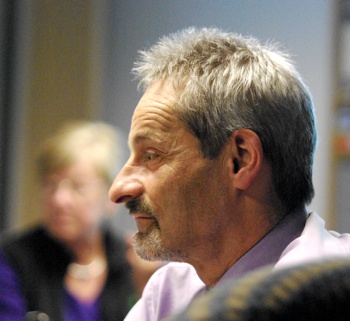
Dan Ezekiel, the newest WCPARC member and former chair of the Ann Arbor greenbelt advisory commission.
Evan Pratt clarified with Vaughn that revisions to the plan are still in line with what WCPARC wants to accomplish. Vaughn noted that Superior Township has also seen the new plans and is supportive. Pratt then asked if a farm management plan would be developed for the site, for the portion of the site that is being actively farmed. WCPARC director Bob Tetens said the tricky thing is that not a lot can be done while Staebler lives on the property. However, WCPARC has talked with Michigan State University about the possibility of a farm incubator program, Tetens said, as well as with the Veterans Affairs hospital about a possible program for veterans who are receiving treatment.
Dan Ezekiel noted that there’s a lot of pent-up demand for fishing, so he was glad to see the fishing piers as part of the project. He also supported the idea of a farm incubator. Pointing to the dramatic decrease in the butterfly population, Ezekiel wondered whether this project could incorporate habitat for butterflies – particularly the Monarch – into the pasture and meadow areas. Other commissioners and staff supported his suggestion.
Janis Bobrin clarified with Tetens that the fishing piers would be accessible to those with disabilities. Tetens replied that the plan’s goal is for universal accessibility throughout the site.
Jan Anschuetz noted that the County Farm Park’s playground has a farm theme, and she wondered if the playground on the Staebler Farm would also have that theme. “Everything we do out there is going to have a farm theme,” Tetens replied.
Sizemore asked if the project would include a petting zoo. It won’t, Tetens replied. Anschuetz noted the proximity to Domino’s Farms, which has a petting farm, and said WCPARC wouldn’t want to compete with a private enterprise.
Outcome: Commissioners unanimously approved applying for the MDNR trust fund grant for Staebler Farm.
Connecting Communities Grants
At WCPARC’s Feb. 11, 2014 meeting, commissioners had reviewed applications for this year’s cycle of Connecting Communities grants, which covered six proposed projects. Staff made recommendations for commissioners to review and approve on March 11. [.pdf of February staff memo] [.pdf of applications] [.pdf of March staff memo with recommendations]
By way of background, in May 2009 WCPARC authorized the Connecting Communities initiative. The program makes up to $600,000 available annually from 2010 through 2014 – a total of $3 million – toward the cost of eligible trail projects. According to a staff memo, “eligible projects will be those that accomplish the Commission’s primary objective of providing valuable non-motorized connections between communities and activity centers, offering a healthy alternative for recreation, transportation, fitness, and energy conservation.” Grant recipients have two years to fulfill any contingencies, such as acquiring grants from other organizations.
As an example, the city of Ann Arbor was granted $300,000 in 2013 (of total cost of $1 million) for 1,500 feet of trail, part of a project for the “development of pathways, storm water features to improve the quality of Allen Creek … on property which will serve as a trailhead for the proposed Allen Creek Greenway.” The site includes city property at 721 N. Main. Paths would connect Felch Street to both North Main and west Summit Street. The proposal stated that the city would also apply for a match from the Michigan Dept. of Natural Resources trust fund (MDNRTF), and that the city would consider using the adopt-a-park program to help maintain the facility. The grant required success with the MDNRTF, but the city’s application in 2013 failed. The city has another year to try again.
WCPARC developed criteria for selecting projects, which include 10 primary considerations. Among those considerations are projects that provide important links between communities, parks and other points of interest, that are adjacent to waterways, or that are major multi-jurisdictional efforts. There are 14 types of projects that generally are not eligible, such as trails solely within existing local parks.
Applicants must document a compelling need for a project. Six criteria that are used to evaluate the projects. For example, projects are evaluated based on whether they directly relate to the county’s important natural features, such as a river. The Huron River corridor is WCPARC’s highest priority. Five secondary criteria – such as land availability, or the likelihood of funding from other sources – are then applied to high-ranking projects.
The process for selecting projects to be funded involves a staff review of the applications. The projects are then presented to the Greenways Advisory Committee, which provides input that staff uses to prioritize the applications and make recommendations to WCPARC for final approval.
Connecting Communities: Applications & Staff Recommendations – Ann Arbor Township
Ann Arbor Township applied for $300,000. The total project cost is $1.2 million for two miles of pedestrian and bicycle trail connecting Parker Mill and Plymouth Road along Dixboro Road, to connect to the Parker Mill trail at Geddes and Dixboro on the south, and the proposed trail from Plymouth/Dixboro to Main Street/Cherry Hill on the north.
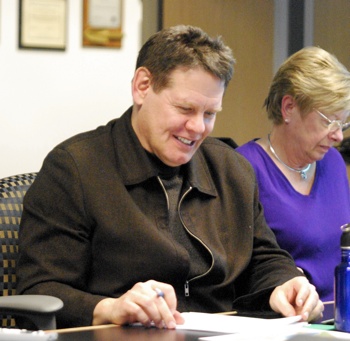
Evan Pratt, county water resources commissioner, and Patricia Scribner, Pittsfield Township treasurer. They both serve on the county parks & recreation commission.
The application states that other confirmed project funders include $600,000 in private donor matching funds. Potential project funders include the Michigan Dept. of Natural Resources trust fund, the Washtenaw County road commission, the Michigan Dept. of Transportation alternatives program, and additional private donors. It’s part of a broader project that WCPARC has taken the lead on, hoping to build partnerships with the township and the University of Michigan to create a north-south Border-to-Border trail connection. The township has received no previous grants from the Connecting Communities program.
Dan Smith noted that he had attended a forum the previous night hosted by Ann Arbor Township about non-motorized pathways. He’d talked with some residents who live on Geddes Road, as well as someone from Pittsfield Township who rides mountain bikes in that area. Smith said he’d been taken aback because these people weren’t too keen about the trail project. The residents were concerned about increased traffic and parking. Parker Mill is already a popular destination. And the mountain biker prefers natural trails over engineered trails, Smith said. “You can’t make everybody happy, he said, adding that he fully supported this project.
WCPARC director Bob Tetens said they try to make the trails accessible to the broadest possible number of people. Last year, he noted, a cyclist had been hit along that section of road, so a non-motorized trail is needed in that area.
Evan Pratt clarified with staff that Ann Arbor Township had never received an MDNR trust fund grant. He suggested that WCPARC staff help out with the application. Tetens said that the staff works with all of the entities that apply for trust fund grants, when WCPARC is offering matching funds. Pratt said he knew that applications including regional trails score higher.
Responding to a query from Bob Marans, Vaughn indicated that the township hadn’t completed its design of the trails yet, but that WCPARC will be involved in that process.
Jan Anschuetz noted that the broader project has been on WCPARC’s “dream list” for more than 20 years, and they’ve put a lot of energy into it. “My poor husband has become a very old man – I don’t know if he’ll be able to walk this trail,” she quipped.
Tetens noted that the university hasn’t always been interested in providing trail connections in its property, which includes the Matthaei Botanical Gardens. But there are some new people who want to make it happen now, he said.
Staff recommendation: $250,000.
Connecting Communities: Applications & Staff Recommendations – Village of Manchester
The village of Manchester applied for $150,000 (of $225,000 total cost) to improve an existing rail bed owned by the village into a walking/biking trail traversing the entire community and linking several parks, businesses, schools, and neighborhoods, ending at the county’s Leonard Preserve.
The Chelsea Area Wellness Foundation will provide $100,000, and the Kiwanis Club of Manchester another $2,000. Potential additional funders include community fundraising and private donations; and grants such as the Moving Ahead for Progress in the 21st Century Act (MAP-21); Transportation Alternatives Program (TAP) and Surface Transportation Program (STP), which are both programs of the Federal Highway Administration in the federal Dept. of Transportation; and the Rails to Trails Conservancy.
The village had previously been awarded $150,000 from the Connecting Communities program in 2011, which it planned to use as matching funds for a Michigan Dept of Natural Resources trust fund grant. However, it decided not to apply for that grant, so the WCPARC funds weren’t awarded. The village now intends to apply for the state grant this year. WCPARC considers this a renewal of the previous 2011 grant, so the money won’t come from the $600,000 in Connecting Communities funds that are available this year.
Staff recommendation: $150,000 (renewal).
Connecting Communities: Applications & Staff Recommendations – Northfield Township
Northfield Township applied for $260,000 (of $600,000 total cost) for 2,925 feet of trail along Barker Road in Whitmore Lake, connecting Whitmore Lake’s downtown with the Northfield Township Library and Whitmore Lake Elementary School. This is the third phase of a project that received $120,000 in 2010 and $250,000 in 2011 from the Connecting Communities program.
Other confirmed project funders are $60,000 from Northfield Township, $60,000 from the Whitmore Lake Downtown Development Authority, $1,000 from the Northfield Area Chamber of Commerce, and $1,000 from the Kiwanis.
Staff recommendation: $250,000.
Connecting Communities: Applications & Staff Recommendations – Pittsfield Township
Pittsfield Township applied for $400,000 (of total cost of $1.9 million) for 1.8 miles of trail, phase 2 of the Lohr-Textile greenway, extending it east from the corner of Lohr and Textile, on Textile, to the Marshview Meadow Park and the Pittsfield Preserve.
Grants from WCPARC’s Connecting Communities project to the township were $300,000 in 2010; $290,000 in 2011; and $150,000 in 2013. Those 2013 funds were intended as matching funds for a MDNR trust fund grant, which the township did not secure.
Confirmed funding is from Pittsfield Township (up to $400,000); and MDOT/SEMCOG through the federal Transportation Alternatives Program (TAP) program ($1,064,708).
Bob Tetens noted that this project is compatible with the township’s State Road corridor improvement authority project. Coy Vaughn pointed out that Pittsfield Township has received more money from Connecting Communities and other WCPARC sources than other communities, but the township has been successful in completing its projects and in leveraging WCPARC’s money to secure other funds.
Staff recommendations: $250,000 as matching funds for the TAP grant. (Includes $100,000 in new Connecting Community funds, and renewal of the $150,000 from 2013.)
Connecting Communities: Applications & Staff Recommendations – Ypsilanti Township
Ypsilanti Township applied for $240,000 for two projects totaling 3,032 feet (total cost of $240,000). One project (2,032 feet) would run along the east side of Tuttle Hill Road from Textile Road north across South Huron River Drive and into Ford Lake Park. The other (1,000 feet) would run on the south side of Textile from just east of South Huron River Drive to the entrance of Lakeview mobile homes.
The township received WCPARC funding for trail projects in 2010, 2011 and 2013.
Bob Tetens noted that one of the criteria for new Connecting Communities funding is that any previously funded project must be completed. The township is still working on finishing the trail that was funded by WCPARC in 2013, he said.
Staff recommendation: No funding for this cycle.
Outcome: Commissioners unanimously approved all staff recommendations for Connecting Communities grants.
Connecting Communities: Next Steps
Bob Marans noted that this is the last year of the five-year Connecting Communities program. He wondered if WCPARC staff was going to recommend continuing it. “There’s always that option,” Bob Tetens replied.

From left: Washtenaw County commissioners Rolland Sizemore Jr. (D-District 5) and Dan Smith (R-District 2) also serve on WCPARC.
Tetens told commissioners that the program has been extremely popular. In surveys of county residents, trails and open space typically rate the highest in terms of support. The Connecting Communities program was developed because WCPARC was receiving a lot of requests from local communities for help with trail projects, and it was difficult to objectively evaluate each project when there weren’t other projects to compare against.
Every year, requests are typically double the amount of available funding, Tetens said. In looking ahead, WCPARC staff had looked at using the funds that would be available after the end of the Connecting Communities program to instead fund debt payments from the proposed east county recreation center, if WCPARC decides to bond for that project. But given the popularity of Connecting Communities, Tetens said, the staff will likely propose keeping some version of it – assuming that the WCPARC operations millage is renewed by voters.
Rolland Sizemore Jr. jokingly asked if some of the money can be used to repair roads. Tetens noted that WCPARC has funded some road shoulder projects, in partnership with the road commission. WCPARC is usually involved in any significant trail project in the county, Tetens said. Much of that is through the Border-to-Border Trail project. In addition to projects in the Connecting Communities program, other trail projects are in the works for North Territorial, and an effort to connect Dexter and Chelsea, among others.
Dan Smith clarified that Tetens anticipates continuing Connecting Communities, but it’s contingent on the millage renewal. That’s right, Tetens replied. “It would be hard to do it if we don’t have that assured cash flow.”
Eastern County Recreation Center
WCPARC director Bob Tetens gave an update on the east county recreation center, a proposed partnership between the city of Ypsilanti and WCPARC in which the city would supply the property and WCPARC would provide the building. The Ann Arbor Y would then contract with WCPARC to manage the center, which would be located on part of the 38-acre Water Street redevelopment area. [For additional background, see Chronicle coverage from WCPARC's Dec. 10, 2013 meeting.]
Tetens said they’ve been working with the city of Ypsilanti on a development agreement. “There are some terms that we’re not fully comfortable with, and I think the city probably has the same feeling,” he said. WCPARC staff have met with attorneys several times to review the agreement, and work on that continues. He thought he’d have a better sense of how it was progressing at the commission’s April meeting.
Paul Schreiber, mayor of Ypsilanti, told commissioners that he wasn’t aware of any “show-stopping” issues.
Earlier in the meeting, Schreiber had spoken during public commentary to update WCPARC on actions by the city of Ypsilanti that affect the rec center. The previous week, on March 4, the Ypsilanti city council approved a purchase agreement for Water Street Flats, a development with 90 residential units. He thought it was something that’s good for the city.
The complex will be rental apartments for residents who earn 50-90% of area median income. For Ypsilanti, that comes out to market rate, he said. So it’s market-rate housing, Schreiber said, that’s being financed through low-income housing tax credits.
The apartments will bring more people to that area, Schreiber said. The development won’t be next to the rec center, but will be nearby – on the south edge of the Water Street property. He thought the complex would attract young professionals making $30,000 to $40,000 a year, just starting out after graduating from Eastern Michigan University or other institutions. There will be some Section 8 housing, he said. Other properties by the same developer – Herman and Kittle Properties – have had Section 8 units for between 4% and 21% of the entire development, he noted. Since this location is on the river, near downtown and the Border-to-Border Trail, “I think we’re going to be on the low end of that [percentage],” he said.
Schreiber told commissioners that there had been a “lot of spirited discussion against it,” but the majority of the Ypsilanti city council decided to approve it. The developer is applying for tax credits and financing. That’s a competitive process, he noted, so it’s still unclear how it will turn out.
Schreiber felt that the project fits in with the rest of the Water Street plans, including the rec center and WCPARC’s goals. Construction would be in 2015, with completion likely in 2016.
Ypsilanti city councilmember Pete Murdock also addressed commissioners, noting that the developer still owns similar properties that it built, “so they’re not just getting in on the front end and then leaving.” He said the developer would also be building a lot of infrastructure that would serve the rest of the site, including several roads, sidewalks and utilities.
Responding to a query from Rolland Sizemore Jr., Murdock said that even if the rec center isn’t built, the apartment project would move forward.
Rolling Hills Water Park Repairs
WCPARC director Bob Tetens described this item as the “convergence of several problems.” Part of the issue is related to the capital improvement program, but a lot is tied to conformance with current regulations, he said.
From the staff memo:
A few years ago, through dye testing, we discovered the Lazy River was leaking water from four of the seven floor and wall expansion joints. As result, this past fall we removed one of the leaking joints to investigate the extent of the problem. It was confirmed that the rubber membrane in the expansion joints had failed causing the leak. To remedy the situation each expansion joint will be removed and replaced.
The operation of the pools and Lazy River are regulated by several County/State and Federal codes or guidelines. One of these is the Virginia Graeme Baker Pool and Spa Safety Act (VGBA) of 2008 (with updates in 2011). This Act was enacted to prevent hazards of drain entrapments in public pools and spas. Since enactment of the VGBA, we initiated replacement of drain grates throughout the Main Pool facility to comply with the 2008 requirements. However, the drain grates within the Lazy River have not been replaced due to their custom configurations and other needed modifications. Now VGBA and State regulations mandate further changes be made to the drain sump structures and grates to be compliant.
“Slide Mountain” and its associate stairway system are some of the original features of the Waterpark. Over time through regular patron usage and weather, the stairs have developed significant deterioration requiring extensive repair and reconstruction.
Due to the complexity of the project work, Stantec Consulting of Michigan (a local engineering firm) was hired to evaluate the above issues and recommend corrective measures to address each. As a result, an RFP was developed and structured to allow a portion of the work to be completed this spring before opening, then resume after Labor Day shut-down. The scope of work is somewhat specialize and the documentation required perspective bidders to demonstrate previous years of experience with this type of project. [.pdf of full staff memo]
Four bids were received in response to the RFP. The low bid was by Baruzzini Construction Co. of Brighton, for $497,549. The firm had worked on the water slide addition last year and is familiar with the Rolling Hills facility, according to the staff memo. Baruzzini also is doing work on Rutherford Pool in Ypsilanti.
The staff recommended approval of this contract with Baruzzini, plus a $35,000 contingency for potential change orders.
Outcome: Commissioners unanimously approved the contract for work at the Rolling Hills water park.
Communications & Commentary
Each WCPARC meeting includes opportunities for public commentary, as well as various communications from staff and commissioners. Here are some highlights.
Communications & Commentary: Deer Management
Two people spoke on the issue of deer damage in the county. Maurita Holland noted that she’d spoken to commissioners at their previous meeting, on Feb. 11, 2014. A group has formed called Washtenaw County for Ecological Balance, she reported, with members including Larry Kestenbaum [Washtenaw County's clerk/register of deeds] and Chris Graham [who serves on Ann Arbor's environmental commission].
Holland pointed out that Time magazine had a picture of a deer on the cover of its last issue in 2013. A chart in the article shows that the deer population has grown more than any other animal since the middle of the last century. In the past 50 years, the U.S. deer population has increased about 800% to about 32 million head, she noted.
The Forest Preserves of Cook County, in Chicago, has developed a sustainability plan, Holland reported, which includes an annual cull of deer. She reported that the city of Jackson, Michigan, has been culling deer for several years. During that time, about 500 deer have been culled in the city and provided to food pantries there.
Holland concluded by asking commissioners what they needed. “We do understand that the political part of this is undoubtedly much more difficult than getting the MDNR in here with a special permit, if you were to vote as a board to do that,” she said. “We know there’s a lot of political fallout and a lot of education that needs to be done.” The new group is very dedicated to this cause, she said, but only in ways that can be as positive as possible.
Barb Lucas also spoke on this issue. She is contracted by Washtenaw County to do environmental shows on WEMU and Community Television Network – called the Green Room. The November show on WEMU focused on deer overpopulation. It had been very illuminating to interview different stakeholders about it, she said, and it led her to feel that people need to find commonalities because there are such passionate feelings on all sides.
Both sides want to preserve life, Lucas said. If the animal rights supporters were educated about the “web of life” and how there are so many different creatures that depend on the ecosystem, they might have a different view. If deer graze heavily in an area, other species will suffer and starve to death, she said. Animal rights activists talk about “species elitism,” Lucas said, so that’s something to talk about – whether it’s better to protect a “charismatic” species like deer or to protect a range of other species too. That might be a way to find common ground, rather than to start by talking about culling deer, which would “polarize everybody immediately,” she said. Lucas concluded by urging commissioners to listen to the Green Room segment on this issue.
Holland spoke again, noting that she’d spoken with Ann Arbor city councilmember Sabra Briere. Holland said that Briere was also very concerned about this issue, and had indicated that she’d be contacting WCPARC because it was a good idea to talk about how this affects both the city and the county. The deer right now are in the county’s northwest quadrant, Holland said, and are moving towards Ann Arbor. “This is going to be a moving target,” she said.
Communications & Commentary: Deer Management – Commission Discussion
Later in the meeting, WCPARC director Bob Tetens noted that the board packet included some material related to this issue. [.pdf of February 2014 staff report on deer populations in county parks] [.pdf of Feb. 17, 2014 Inside Michigan Politics article] [.pdf of Meridian Township deer management plan] [.pdf of 2012 Ann Arbor Observer article]
Tetens thanked Holland and Lucas for providing more information, and told commissioners that WCPARC staff would be collecting as much information as possible. He reported that WCPARC has applied for a $29,960 grant through the Michigan Dept. of Natural Resources wildlife habitat grant program. Those funds would allow WCPARC to quantify the impact on county parks and preserves more precisely.
Tetens told commissioners that this will now be a regular agenda item, as the staff continues to research this issue. He noted that the county board of commissioners held a working session in February that focused on the deer population in Washtenaw County, which included a presentation by Timothy Wilson of the U.S. Dept. of Agriculture.
Everyone agrees that the growing deer population is a problem, Tetens said, but “nobody can solve it on their own.”
Bob Marans asked about a timeframe for putting some kind of plan in place. Dan Smith, who serves on the county board representing District 2, described a couple of points from the February working session. The USDA would assist in helping carry out various remediations, he said, but only after some other entity assesses the problem. In Michigan, that falls to the DNR and local entities.
Smith also reported that the “lethal” technique was surprisingly expensive. He’d expected that to be the least expensive, but that wasn’t the case. According to the USDA, the most effective technique would be even more unpopular than other management efforts, Smith said – to bring back natural predators. “That would be even more unpopular than bow hunters.”
Marans asked Tetens where he saw this headed, in terms of WCPARC’s role. Tetens replied that the DNR is responsible for managing the deer population, so ultimately it would need to be a collaborative effort with the DNR, local communities, the Farm Bureau, and others.
Marans then asked: “Is it our responsibility to push the DNR?” It’s everyone’s responsibility, Tetens replied. Right now, it’s a problem that the county can’t manage alone. The USDA representative had noted that even if the problem is solved in one location, the deer move elsewhere, he said.
As a society, “we have created the perfect environment, with our rural residential development,” Tetens said. Scio Township has been in the top five municipalities statewide in terms of the number of deer-vehicle accidents, he noted. Hunting is limited, while suburban homes plant landscape gardens that attract deer. He likened it to putting up a sign that says: “We’re not going to hunt you. Here’s free food. Come on in!” There needs to be a cultural shift, Tetens said.
Dan Smith said that from a policy perspective, WCPARC can be a driver as far as the county is concerned, because it manages significant acreage in parks and natural areas. The elected county board of commissioners has indirect control, but the county board doesn’t directly own a lot of land.
Marans agreed that WCPARC plays an important role, but “the directive should come from the county board,” he said.
Smith noted that the townships in Michigan have the most control over land use issues, so it’s important to work with the township officials too. Based on his research, Smith said, it’s clear that there are conflicting interests – farmers want one thing, hunters want another, conservationists want yet another thing, depending on what type of conservationist they are.
Janis Bobrin referred to a point that Barb Lucas had made regarding the need to find common ground. “This is a community where if we start talking about killing anything, there are people who will just not hear anything after that,” she said. There’s the actual management of the problem, she noted, but also a major education piece. “How do we begin to get a dialogue that isn’t one camp against another? That would seem to be a productive first step.”
Jan Anschuetz said it would be presumptuous to say that culling deer would solve the problem. About five years ago, WCPARC considered the issue seriously, she said, adding that she’d spent about 40-50 hours researching the problem at that time. Studies that she’d read revealed that culling deer actually encourages reproduction. It’s a very complicated issue, she said, and WCPARC shouldn’t just jump into it.
Marans replied that clearly they need to move slowly. He described a deer management program at the Huron-Clinton Metropolitan Authority, which he said was very successful. [Marans also serves on the board of the HCMA, which oversees the Huron-Clinton Metroparks.] He noted that HCMA has more land than WCPARC, and it’s also hard to know what happens on land outside of the metroparks.
Anschuetz urged commissioners and staff to be “a little bit humble.” They need to work with and listen to the animal rights advocates, she said.
Dan Smith noted that it’s clear the deer are harming native plants and wildlife in the county’s preserves. The reason the county invests in these preserves is to ensure that native plants and wildlife have protected areas. He thought that managing the deer population could be part of the broader management efforts for those areas. But the success of that management isn’t known, he added. Smith said he’d read that deer have evolved so that their reproduction is a way to survive predators. When there are no predators – aside from vehicles – then they overpopulate.
Evan Pratt said it would be helpful to get feedback from staff about what WCPARC’s role should be. Should they be hosting symposiums? Or just providing information?
Anschuetz argued that WCPARC exists in order to serve the entire population of Washtenaw County that pays for parks. “If we do something that displeases our public, we will not have a millage and will not have a parks commission and we will not have a preserve,” she said. Deciding how to handle the deer issue is an important decision, she added – not just for the people who are concerned about this issue, but for the entire parks system.
Dan Ezekiel suggested seeing if there are any resources at the University of Michigan School of Natural Resources & Environment.
Dan Smith asked if Tetens would be comfortable preparing a recommendation over the next month or two. Smith said it sounded like Marans wanted direction from the county board of commissioners. Marans thought the county could be a leader in initiating a program, whatever that might be. It wasn’t wise to just be passive, he said.
Tetens said his staff hadn’t been able to spend much time on this issue so far. Marans wanted to see a proposal for various options within six months or so.
Regarding HCMA’s deer management, Anschuetz pointed out that HCMA’s millage is permanent and doesn’t require renewal. But WCPARC’s millage does need renewal, she noted, and “if we aren’t representing the community, we are in a very vulnerable position.” Marans countered that commissioners don’t know what the community thinks as a whole.
Bobrin said that Anschuetz’s point is well taken – WCPARC needs to understand that. Anschuetz told commissioners that she’s very involved in animal rights issues, and is very involved with the Humane Society. “I know what goes on,” Anschuetz said. “You may be underestimating the power of the people in this community.” She didn’t see WCPARC as leading this effort, but rather they should partner with other entities.
Pratt drew an analogy to weed control in lakes. Once you start spending money to try to manage it, “you’re just rolling the rock up the hill,” he said. “You just start this Sisyphean task when you try to force-fit nature into what you want it to be.” He said he wasn’t arguing against a deer management program, but WCPARC first needs to figure out what its role should be.
Dan Smith said he wasn’t suggesting that WCPARC take on deer management itself. But because they’ve invested in preserves, that’s why WCPARC has a role in it. “If the preserve just becomes a bunch of prairie grass, that’s not a very interesting preserve,” he said. “That’s not why we’re buying this land with tax dollars.”
Smith noted that if the best solution turns out to be introducing natural predators to the area, that introduces an entirely new set of problems. “Now the farmers will really be up in arms,” he said.
Communications & Commentary: Lyndon Township Mining Proposal
McCoig Materials is proposing a sand and gravel mine in Lyndon Township, on 189 acres north of Chelsea on M-52. The rural site is located near several parks and nature areas, including Waterloo State Recreation Area, the Pinckney State Recreation Area, Park Lyndon, the Green Lake Camping area, and the Waterloo-Pinckney Hiking Trail.
Bob Tetens reminded commissioners that the southern part of WCPARC’s Park Lyndon covers most of the edges of Lake Genevieve, and “we’ve always sort of felt, despite where the fences are at, that the whole lake was ours, and it’s not.” A small portion of the southern tip of the lake is part of the Cunningham family property – the site that McCoig wants to purchase.
In the past, WCPARC had talked to the family about possibly buying that land, Tetens said. WCPARC has been interested in it for at least two decades.
Residents in the area are very concerned about McCoig’s proposal, Tetens said. It would mean a lot of additional traffic from trucks – 60-80 round-trip gravel haulers each day would be driving through Chelsea, throughout the estimated 30-year life of the operation. There are also concerns about the impact on local ecosystems and hydrology, Tetens said.
Part of what makes the northwest part of Washtenaw County so special is its concentration of parks and recreation areas, Tetens said, so it doesn’t make sense to take 190 acres out of that for mining.
Tetens asked for the commissioners to support drafting a letter to Lyndon Township and state officials, opposing a special use permit that would allow the company to remove sand and gravel. He stressed WCPARC’s continued interest in buying the property for the county’s natural areas preservation program, and said that an application for NAPP had been sent to the Cunningham family. The resources are available in NAPP’s budget to buy the property at fair market value, Tetens said. Any added value related to mineral rights would have to be negotiated.
Tetens also reported that the Michigan Dept. of Natural Resources has been working with McCoig to try to find an alternative site – possibly property that the DNR owned or could acquire, that could be traded for the Cunningham property so that the ecosystem in that area could be maintained.
Janis Bobrin noted that because of relatively recent state legislation, it’s very difficult for local governments to turn down mining operations in their communities.
On its website, Lyndon Township has noted that its authority is limited:
Michigan State Legislators have greatly reduced township control by passing Act 110 of 2006 (125.3205). Under that law, the township must not “prevent the extraction, by mining, of valuable natural resources from any property unless very serious consequences would result from the extraction of those natural resources. Natural resources are considered valuable for the purposes of this section if a person, by extracting the natural resources, can receive revenue and reasonably expect to operate at a profit.” The township’s authority is limited to “reasonable regulation of hours of operation, blasting hours, noise levels, dust control measures, and traffic that are not preempted by part 632 of the Michigan environmental laws,” 1994 PA 451, MCL 324.63201 to 324.63223.
Outcome: Commissioners voted unanimously to direct staff to send a letter to Lyndon Township regarding the McCoig proposal. [.pdf of Tetens letter]
Communications & Commentary: Millage Renewal
Bob Tetens updated commissioners on the process of renewing the county’s 10-year parks & recreation operations millage, which is likely to be on the November 2014 ballot.
The countywide parks & recreation operations millage is a 10-year, quarter-mill tax that was first approved in November 1976 1978, and subsequently renewed in 1984, 1994, and 2004. The current millage expires on Dec. 1, 2016. Typically, a renewal proposal is put on the ballot two years before the existing millage expires.
Tetens said there will be two separate tracks. The county staff and commission can market its services and programs to the greatest extent possible – that’s well underway, he said. As part of that, staff are developing the next five-year strategic plan.
In 2004, when the millage was most recently renewed, the county board of commissioners – the elected body that has the authority to put a millage proposal on the ballot – was asked to do that in June, Tetens said. That’s likely the timeframe that will be followed this year. WCPARC staff will be making a presentation to the county board to describe what’s been done in the past 10 years. “We’ve got a good story to tell about that,” he said. The presentation will also include a planning document about how the millage would be used in the next 10 years.
Parallel to that is the organization called Friends of the County Parks. It’s the group that handles fundraising for the millage campaign itself, Tetens explained. Nelson Meade, the long-time WCPARC member who retired in December of 2013, used to lead that effort. Tetens said that commissioners might want to designate someone to serve as treasurer of that group, in place of Meade.
Financial Reports
Each month, staff provide several different financial reports to WCPARC, focused on the past month’s expenses (the claims report), monthly and year-to-date reports on expenses and revenues in the form of fund balance reports, and a listing of major non-recurring expenses when they are significant.
There are separate reports on parks and facilities, and on the natural areas preservation program (NAPP), which includes preservation of agricultural lands. Each of these has its own, separate funding, although WCPARC administers all of these programs.
Financial Reports: Claims Report
Director Bob Tetens began by saying that the reports reflect WCPARC’s off season. Parks and facilities paid a total of $113,859 in claims during February. Most of those expenses were for capital improvements, primarily at the Meri Lou Murray Recreation Center and Rolling Hills.
NAPP claims totaled $661,101 in February. Most of those expenses – $613,784 – were spent on a conservation easement for the Bloch property in Superior Township, which commissioners had approved at their Feb. 11, 2014 meeting.
Total expenses in February were $774,961. [.pdf of February 2014 claims]
Financial Reports: Fund Balance – Parks and Recreation
Tetens noted that there hadn’t been any dramatic changes since the previous month’s report.
January 2014 began with a fund balance of $10,521,250. [This is the total of the $3,146,250 fund balance on Dec. 31, 2013, plus the $6.7 million operating reserve and the $675,000 committed to funding partnerships.] Revenue as of Feb. 28, 2014 was $4,128,849 with expenses of $696,711. The operating reserve for 2014 is $6.7 million, and the funding commitments for partnerships is $820,000. [.pdf of February 2014 parks & rec fund balance]
The projected fund balance at the end of 2014 is $6,430,817.
Financial Reports: Fund Balance – NAPP
The February report started with the fund balance of $7,195,911 and showed revenue of $1,968,881. Expenses totaled $622,947, for a projected fund balance at the end of 2014 of $8,450,839. [.pdf of February 2014 NAPP fund balance]
There was no substantive discussion of the reports.
Outcome: WCPARC unanimously voted to receive, accept, and file the financial reports.
Recreation Reports
Typically, there are several monthly reports on attendance at WCPARC facilities where attendance can be counted, with information about participation in measurable activities and revenue received at those facilities. The reports include the current year-to-date summary as well as similar information for the prior two years.
For the March 11 meeting, only one recreation report was presented.
Recreation Reports: Meri Lou Murray Recreation Center
At the Meri Lou Murray Recreation Center, year-to-date participation as of Feb. 28, 2014 was 56,541 and revenue was $250,023. In 2013, year-to-date participation was 63,615 and revenue was $262,635. In 2012, participation was 67,824 and revenue was $249,565. [.pdf of MLM recreation center report]
WCPARC director Bob Tetens noted that activity had been slow during February, which he attributed to the bad weather. “People just weren’t getting out,” he said.
Tetens reminded commissioners that two years ago, the county’s Pierce Lake golf course opened in the third week of March, and in 2013 they opened in the last week in March. So things will be slow at the golf course this year too, he said.
Outcome: The recreation report was received and accepted for filing unanimously.
Projects and Activities
Staff of WCPARC provide monthly updates to commissioners about ongoing improvements at facilities, and activities at parks and natural areas. Some of this information is provided in writing in the board packet; more is provided with visuals and informal commentary. [.pdf of projects/activities report]
Here are some highlights of items discussed at the March meeting.
- The annual ice fishing derby at Independence Lake had a good turnout, Coy Vaughn reported. Rolland Sizemore Jr. observed that in the photos that Vaughn showed of the event, there weren’t any minorities. He asked how WCPARC advertised the event. Vaughn replied that they used posters, partnered with businesses like Cabela’s and local bait shops, and posted information online. WCPARC director Bob Tetens said there is typically a larger turnout of minorities for events at Rolling Hills, on the county’s east side.
- The annual “Daddy Daughter Dance” at the Meri Lou Murray recreation center on Feb. 22 drew 168 people this year. Vaughn played a clip from a feature about the dance that aired on Community Television Network’s FYI show.
- A summer job fair was held at the gym in the Meri Lou Murray recreation center, with several county departments and the Michigan Works office represented. Attendees could apply and be interviewed on the spot. It drew over 100 people.
- Vaughn showed two short videos that will be used to promote various WCPARC facilities online. He plans to show one or two new videos at each WCPARC meeting over the next few months. The videos shown on March 11 highlighted County Farm Park and the water parks at Rolling Hills and Independence Lake.
Remembering Fred Veigel
The March 11 board packet included a resolution of appreciation for Fred Veigel, who died on March 2. [.pdf of resolution] Veigel was a long-time WCPARC member who held a seat designated for a county road commission representative.
WCPARC director Bob Tetens described Veigel as “an even more colorful figure than we’d realized,” based on pictures that had been on display at Veigel’s memorial and funeral. Veigel had been a member of International Brotherhood of Electrical Workers Local 252 for 60 years, and the union is planning a memorial “toast and roast” on Friday, June 13.
Evan Pratt noted that the family is encouraging people to come and share stories about Veigel. “It sounded like there weren’t going to be many boundaries,” he said.
Outcome: Commissioners passed the resolution of appreciation.
Present: Jan Anschuetz, Janis Bobrin, Dan Ezekiel, Robert Marans, Evan Pratt, Patricia Scribner, Rolland Sizemore Jr., and Dan Smith.
Absent: Conan Smith.
Staff: Director Bob Tetens, deputy director Coy Vaughn.
Next meeting: Tuesday, April 8, 2014 at 7 p.m. in the county parks and recreation department’s office at 2230 Platt Road in Ann Arbor.
The Chronicle could not survive without regular voluntary subscriptions to support our coverage of public bodies like the Washtenaw County parks and recreation commission. Click this link for details: Subscribe to The Chronicle. And if you’re already supporting us, please encourage your friends, neighbors and colleagues to help support The Chronicle, too!




